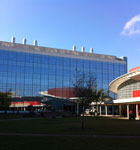When the University of Houston wanted to attract the best scientists and engineers, thereby helping the university reach its goal of becoming a top-ranked research institution, a state-of-the art research and teaching complex seemed the best way to achieve that goal. “We’re located in the city of Houston, and Houston is big in the energy field, so the university wanted to take the lead running scientific and engineering programs,” says Paul Brokhin, the university’s utility and sustainability coordinator. The result was the Science and Engineering Research Center (SERC), which houses the College of Natural Sciences and Mathematics and the College of Engineering.
 To design the building, the university turned to world-renowned architect Cesar Pelli of Pelli Clarke Pelli Architects, who in turn assembled a team of architects who had scientific backgrounds in addition to architectural expertise. Pelli’s vision, sited among the university’s existing science buildings, was a complex that would encourage collaboration, and he achieved this idea with an open design unique among scientific facilities containing multiple laboratories.
To design the building, the university turned to world-renowned architect Cesar Pelli of Pelli Clarke Pelli Architects, who in turn assembled a team of architects who had scientific backgrounds in addition to architectural expertise. Pelli’s vision, sited among the university’s existing science buildings, was a complex that would encourage collaboration, and he achieved this idea with an open design unique among scientific facilities containing multiple laboratories.
The 191,000-square-foot complex consists of a five-story laboratory building, a two-story classroom building, and a 550-seat teaching auditorium, all unified by a central courtyard. At the heart of the complex, the 152,460-square-foot laboratory building is a perfect example of Pelli’s vision of design that facilitates interaction. Developed in conjunction with University of Houston scientists and engineers, it features multiple labs that open up to other labs—no walls between them. Collaborative research is facilitated by the building’s ground-floor “clean room.” Among the first of its kind in Houston, this room, which is of the caliber found at major pharmacological institutions, features a non-vibrating floor, static-free conditions, and special air filters to remove virtually all dust particles. Ultimately, it controls vibrations and reduces contamination that can jeopardize delicate experiments.
Visually, the complex both adds a modern element to the campus and complements the existing structures by using materials and colors drawn largely from adjacent buildings and the campus as a whole. The classroom building, for example, is clad in a buff-colored brick wall with glass and metal windows, and the auditorium is enclosed in a diamond-patterned, red-brick wall. The research building is surrounded on its sunnier south side by a curtain wall of limestone and on its shadier north side by a mostly glass wall with metal spandrels.
Brokhin says the $81 million SERC—which Buildings magazine awarded a citation of excellence in its new construction category in October 2008—positions the University of Houston as a leader in research and opens the door for collaboration not just between the science and engineering departments but between the university and other institutions. “The engineering and science faculty—as well as local industry partners—all come together to participate in the university’s research efforts,” he says.
The building was completed in 2005, when sustainability wasn’t part of the university’s focus, so it wasn’t planned as a LEED effort. But it still came naturally, says Brokhin, thanks to the University of Houston’s commitment to meeting the highest ASHRAE standards. “All new buildings are required to meet ASHRAE 90.1, and in pursuing that, the building easily achieved LEED Silver,” he explains.
Today, the University of Houston is doggedly pursuing a green agenda through renovation and new construction. It recently designed a master plan for the campus, which it will complete over the next 20 years—and that’s on top of the more than $220 million in campus improvements the school has already made. “Our goal is to create a more pedestrian-friendly environment,” Brokhin says, “and we have vowed to complete all new projects to at least LEED Silver.”

